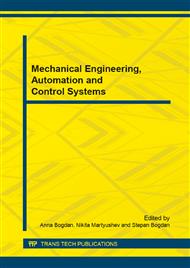p.105
p.111
p.116
p.120
p.126
p.132
p.137
p.144
p.150
Influence of Chip Formation Characteristics on Flank Contact Load Distribution in Titanium Alloy Cutting
Abstract:
In this paper different contact conditions between tool, chip and work material are analyzed. Experimental and theoretical studies of contact load distribution on the artificial flank wear land of the cutter in free orthogonal turning of a disk made from titanium alloy (Ti-6Al-2Mo-2Cr) are described. Investigations of cutting with various feed rate and cutting speed show that the greatest contact loads are observed immediately at the cutting edge. It is associated with the discontinuous character of titanium alloy chip and the elastic recovery of the transient (machined) surface at the moment when generated chip element is separated. The main influence of the variable chip thickness ratio of the discontinuous chip on the value of the greatest normal contact load near the cutting edge is shown that confirms the author’ hypothesis about a sag of the transient surface in the cutting edge region.Abbreviation and symbols: m/s – meter per second (cutting speed v); mm/r – millimeter per revolution (feed rate f); MPa – mega Pascal (specific contact load as stress σ or τ); hf – the width of the flank wear land of the cutting tool, flank wear land can be natural or artificial like in this paper [mm]; xh – distance from the cutting edge on the surface of the flank wear land [mm]; σh – normal specific contact load on the flank land [MPa]; τh – shear (tangential) specific contact load on the flank land [MPa]; HSS – high speed steel (material of cutting tool); Py r – radial component of cutting force on the rake face [N]; Pz – tangential component of cutting force [N]; γ – rake angle of the cutting tool [°]; α – clearance angle of the sharp cutting tool [°]; αh – clearance angle of the flank wear land [°]; b – width of a machined plate or disk [mm]; a – the thickness of the layer being removed (uncut chip thickness) [mm]; a1 – chip thickness [mm]; Ka – chip thickness ratio (Ka = a1/a) as a degree of plastic deformation in chip formation zone; Ka2 – variable chip thickness ratio, Ka2 = a2/a1, where а2 – distance from the rake face surface of the chip to the contact point of two neighbouring elements of the chip [mm]; Φ – shear angle [°]; hd – value, which determines the depth of deformation, for an ordinary task it is equal to the thickness of the machined part or the radius r of the machined disk [mm]; q – intensity of loading in the chip formation region [MPa].
Info:
Periodical:
Pages:
126-131
Citation:
Online since:
April 2015
Authors:
Keywords:
Price:
Сopyright:
© 2015 Trans Tech Publications Ltd. All Rights Reserved
Share:
Citation:


